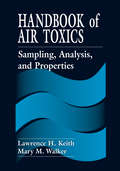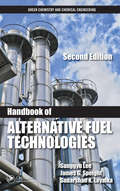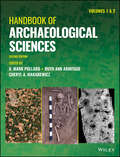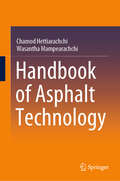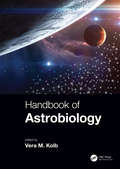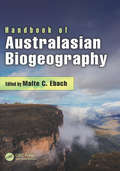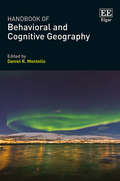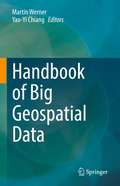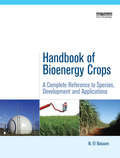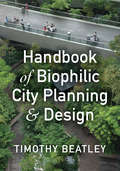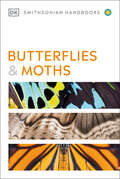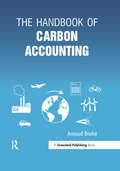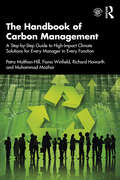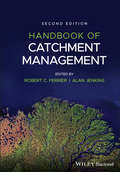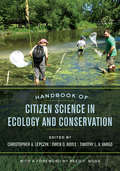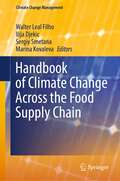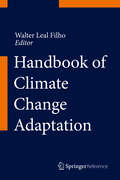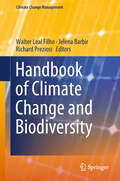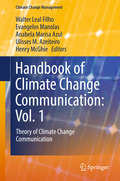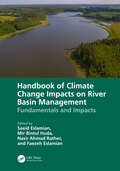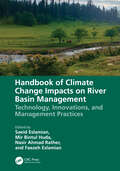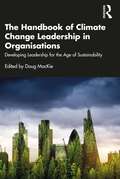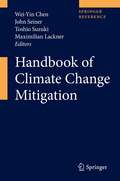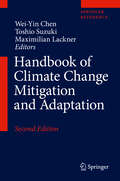- Table View
- List View
Handbook of Air Toxics: Sampling, Analysis, and Properties
by Lawrence H. Keith Mary WalkerThe Handbook of Air Toxics compiles, defines, and clarifies several methods and concepts of airborne toxic substances found in the environment. This comprehensive reference helps regulators, consultants, and other environmental professionals meet the challenges of sampling and analysis, emissions reductions, and health and safety issues related to human exposure. It is an important reference addressing the ongoing concern about the consequences of air pollution, and the implementation and modification of the Environmental Protection Agency's (EPA) Clean Air Act.Some of the methods described in the Handbook of Air Toxics include fluorescence, thermal desorption, selected ion monitoring, ion chromatography, light microscopy, specific electrode analysis, titration, colorimetry, atomic absorption, and spectrophotometry. It also covers the use of isokinetic sampling trains, midget impingers, carbon molecular sieves, and sampling canisters in the analysis of air toxics. The Handbook also contains recommendations from the EPA for analytical methods for those air toxics where methods do not already exist and provides advance information on future method development by the EPA.
Handbook of Alternative Fuel Technologies (Green Chemistry and Chemical Engineering)
by Sunggyu Lee James G. Speight Sudarshan K. LoyalkaWhile strides are being made in the research and development of environmentally acceptable and more sustainable alternative fuels-including efforts to reduce emissions of air pollutants associated with combustion processes from electric power generation and vehicular transportation-fossil fuel resources are limited and may soon be on the verge of d
Handbook of Archaeological Sciences
by A. Mark Pollard Ruth Ann Armitage Cheryl A. MakarewiczHANDBOOK OF ARCHAEOLOGICAL SCIENCES A modern and comprehensive introduction to methods and techniques in archaeology In the newly revised Second Edition of the Handbook of Archaeological Sciences, a team of more than 100 researchers delivers a comprehensive and accessible overview of modern methods used in the archaeological sciences. The book covers all relevant approaches to obtaining and analyzing archaeological data, including dating methods, quaternary paleoenvironments, human bioarchaeology, biomolecular archaeology and archaeogenetics, resource exploitation, archaeological prospection, and assessing the decay and conservation of specimens. Overview chapters introduce readers to the relevance of each area, followed by contributions from leading experts that provide detailed technical knowledge and application examples. Readers will also find: A thorough introduction to human bioarchaeology, including hominin evolution and paleopathology The use of biomolecular analysis to characterize past environments Novel approaches to the analysis of archaeological materials that shed new light on early human lifestyles and societies In-depth explorations of the statistical and computational methods relevant to archaeology Perfect for graduate and advanced undergraduate students of archaeology, the Handbook of Archaeological Sciences will also earn a prominent place in the libraries of researchers and professionals with an interest in the geological, biological, and genetic basis of archaeological studies.
Handbook of Asphalt Technology
by Wasantha Mampearachchi Chamod HettiarachchiThis book provides a comprehensive overview of asphalt materials, serving as a valuable resource for practicing engineers, laboratory technicians, researchers, engineering students, and academics. It covers both fundamental principles and advanced theoretical concepts, ensuring a well-rounded understanding of asphalt technology.The content is structured around the three primary components of asphalt—bitumen, aggregates, and asphalt mixtures—detailing their properties, characteristics, and roles in pavement performance. Additionally, the book delves into practical engineering aspects such as base preparation, material delivery, compaction, laying techniques, asphalt mixture design, quality control, and quality assurance, offering insights that are highly relevant to industry professionals. Furthermore, the book explores various types of asphalt pavements, modern mix design methodologies such as Balanced Mix Design (BMD) and Superpave Mix Design, and emerging trends in asphalt technology, making it an indispensable guide for those involved in the development and advancement of sustainable and high-performance pavements.
Handbook of Astrobiology (Series in Astrobiology)
by Vera M. KolbRead an exclusive interview with Professor Vera Kolb here. Astrobiology is the study of the origin, evolution, distribution, and future of life on Earth. This exciting and significant field of research also investigates the potential existence and search for extra-terrestrial life in the Solar System and beyond. This is the first handbook in this burgeoning and interdisciplinary field. Edited by Vera Kolb, a highly respected astrobiologist, this comprehensive resource captures the history and current state of the field. Rich in information and easy to use, it assumes basic knowledge and provides answers to questions from practitioners and specialists in the field, as well as providing key references for further study. Features: Fills an important gap in the market, providing a comprehensive overview of the field Edited by an authority in the subject, with chapters written by experts in the many diverse areas that comprise astrobiology Contains in-depth and broad coverage of an exciting field that will only grow in importance in the decades ahead
Handbook of Australasian Biogeography (CRC Biogeography Series)
by Malte C. EbachThe Handbook of Australasian Biogeography is the most comprehensive overview of the biogeography of Australasian plants, fungi and animal taxa in a single volume. This volume is unique in its coverage of marine, freshwater, terrestrial, and subterranean taxa. It is an essential publication for anyone studying or researching Australasian biogeography. The book contains biogeographic reviews of all major plant, animal and fungal groups in Australasia by experts in the field, including a strong emphasis on invertebrates, algae, fungi and subterranean taxa. It discusses how Australasia is different from the rest of the world and what other areas share its history and biota.
Handbook of Behavioral and Cognitive Geography
by Daniel R. MontelloThis comprehensive Handbook summarizes existing work and presents new concepts and empirical results from leading scholars in the multidisciplinary field of behavioral and cognitive geography, the study of the human mind, and activity in and concerning space, place, and environment. It provides the broadest and most inclusive coverage of the field so far, including work relevant to human geography, cartography, and geographic information science.Behavioral and cognitive geography originated as a contrast to aggregate approaches to human geography that treat people as homogenous and interchangeable; to models of human activity based on simplistic and psychologically implausible assumptions; and to conceptualizations of humans as passive responders to their environment. This Handbook is highly multi- and interdisciplinary, featuring scholars from geography, geographic information science, and more than ten other academic disciplines; including: psychology, linguistics, computer science, engineering, architecture and planning, anthropology, and neuroscience. The contributors adhere to scientific rigor in their approach, while fully engaging with issues of emotion, subjectivity, consciousness, and human variability.Thoroughly informed by the history of geography and of the cognitive sciences but also providing guideposts for future research and application, this Handbook will be an essential resource for researchers, lecturers and students in geography, psychology, and other social, behavioral, cognitive, and design sciences.
Handbook of Big Geospatial Data
by Martin Werner Yao-Yi ChiangThis handbook covers a wide range of topics related to the collection, processing, analysis, and use of geospatial data in their various forms. This handbook provides an overview of how spatial computing technologies for big data can be organized and implemented to solve real-world problems. Diverse subdomains ranging from indoor mapping and navigation over trajectory computing to earth observation from space, are also present in this handbook. It combines fundamental contributions focusing on spatio-textual analysis, uncertain databases, and spatial statistics with application examples such as road network detection or colocation detection using GPUs. In summary, this handbook gives an essential introduction and overview of the rich field of spatial information science and big geospatial data. It introduces three different perspectives, which together define the field of big geospatial data: a societal, governmental, and governance perspective. It discusses questions of how the acquisition, distribution and exploitation of big geospatial data must be organized both on the scale of companies and countries. A second perspective is a theory-oriented set of contributions on arbitrary spatial data with contributions introducing into the exciting field of spatial statistics or into uncertain databases. A third perspective is taking a very practical perspective to big geospatial data, ranging from chapters that describe how big geospatial data infrastructures can be implemented and how specific applications can be implemented on top of big geospatial data. This would include for example, research in historic map data, road network extraction, damage estimation from remote sensing imagery, or the analysis of spatio-textual collections and social media. This multi-disciplinary approach makes the book unique.This handbook can be used as a reference for undergraduate students, graduate students and researchers focused on big geospatial data. Professionals can use this book, as well as practitioners facing big collections of geospatial data.
Handbook of Bioenergy Crops: A Complete Reference to Species, Development and Applications (Routledge Studies in Bioenergy)
by N. El BassamBiomass currently accounts for about fifteen per cent of global primary energy consumption and is playing an increasingly important role in the face of climate change, energy and food security concerns. Handbook of Bioenergy Crops is a unique reference and guide, with extensive coverage of more than eighty of the main bioenergy crop species. For each it gives a brief description, outlines the ecological requirements, methods of propagation, crop management, rotation and production, harvesting, handling and storage, processing and utilization, then finishes with selected references. This is accompanied by detailed guides to biomass accumulation, harvesting, transportation and storage, as well as conversion technologies for biofuels and an examination of the environmental impact and economic and social dimensions, including prospects for renewable energy. This is an indispensable resource for all those involved in biomass production, utilization and research.
Handbook of Biophilic City Planning & Design
by Timothy BeatleyWhat if, even in the heart of a densely developed city, people could have meaningful encounters with nature? While parks, street trees, and green roofs are increasingly appreciated for their technical services like stormwater reduction, from a biophilic viewpoint, they also facilitate experiences that contribute to better physical and mental health: natural elements in play areas can lessen children's symptoms of ADHD, and adults who exercise in natural spaces can experience greater reductions in anxiety and blood pressure.The Handbook of Biophilic City Planning & Design offers practical advice and inspiration for ensuring that nature in the city is more than infrastructure--that it also promotes well-being andcreates an emotional connection to the earth among urban residents. Divided into six parts, the Handbook begins by introducing key ideas, literature, and theory about biophilic urbanism. Chapters highlight urban biophilic innovations in more than a dozen global cities. The final part concludes with lessons on how to advance an agenda for urban biophilia and an extensive list of resources.As the most comprehensive reference on the emerging field of biophilic urbanism, the Handbook is essential reading for students and practitioners looking to place nature at the core of their planning and design ideas and encourage what preeminent biologist E.O. Wilson described as "the innate emotional connection of humans to all living things."
Handbook of Butterflies and Moths (DK Handbooks)
by David CarterA compact, comprehensive field guide to over 500 butterfly and moth species from around the world.The clearest and sharpest recognition guide to over 500 butterfly and moth species from around the world. Authoritative text, crystal-clear photography, and a systematic approach make this the most comprehensive and concise pocket guide to the butterflies and moths of the world. Packed with more than 600 full-colour photographs of over 500 species, this handy reference book is designed to cut through the process of identification and help you to recognize a species quickly and easily. Expertly written and thoroughly vetted, each entry combines a precise description with annotated photographs to highlight the characteristics and distinguishing features of each butterfly or moth, while also providing at-a-glance facts for quick reference. The introduction explains the difference between butterflies and moths, details the life cycle from egg to adult, rearing your own specimens, and offers guidance for finding and observing live specimens in the wild. A concise glossary defines technical and scientific terms. Compact enough to take out into the field, DK Handbooks: Butterflies & Moths makes identifying these beautiful insects easier than ever before.
The Handbook of Carbon Accounting
by Arnaud BrohéCarbon Accounting is a vital tool in enabling organisations to measure and report on their greenhouse gas emissions. As the need to respond to the causes and impacts of climate change becomes increasingly urgent, emissions calculations and inventories are a vital first step towards mastering climatic risk. The Handbook of Carbon Accounting offers an accessible and comprehensive presentation of the discipline. The book examines the different methods or instruments implemented by countries and companies – such as carbon taxation, carbon markets and voluntary offsetting – while revealing how these stem not simply from the aim of reducing emissions for the lowest cost, but more as a compromise between divergent interests and individual world views. It also explores the historical context of the emergence of carbon accounting, assessing its evolution since the Rio Conference in 1992 and the signing of the Kyoto Protocol in 1997, to the latest Conference of Parties in 2015 in Paris.The book concludes with a very practical guide to calculate, reduce, offset and disclose your carbon footprint.Like other management tools, carbon accounting may not be an exact science, but its contribution has never been more important. The Handbook of Carbon Accounting is a vital educational resource that will help readers – including those with no prior knowledge of the field – to understand carbon flows and stocks and to take action. It forms part of a movement that heralds the start of a new economic era in which the search for prosperity can live in harmony with the environment.
The Handbook of Carbon Management: A Step-by-Step Guide to High-Impact Climate Solutions for Every Manager in Every Function
by Petra Molthan-Hill Fiona Winfield Richard Howarth Muhammad MazharEvery manager and every employee in every function can embed climate solutions and reduce greenhouse gas emissions. This book, written by experts in the field of sustainability in business, shows you how. The climate crisis is one of the greatest challenges we face today, and it affects all aspects of business and society. Consequently, everyone needs to know the best high-impact climate solutions that can be embedded into their organisational area. In this book you will find ideas for your team, your department and your organisation to make this a reality. We provide you with implementation plans and inspiring case studies, with practical and helpful tools that will help you to scale up climate solutions effectively and efficiently. If you are an owner of a company or an executive in any organisation, you will benefit from this step-by-step guide on how to set up your own greenhouse gas management plan, how to set targets and how to reduce the greenhouse gas emissions of your whole organisation. We explain key terms such as Net Zero, Carbon Neutral, carbon emissions equivalents and the three scopes. In order to halve our emissions worldwide by 2030 to achieve Net Zero by 2050, individual actions on a large scale are required, but also systemic changes. We look at the bigger picture in this book and also how you could effect change. This is the first book to offer an easy-to-implement approach to decarbonise organisations and transform societies, and is appropriate for managers at any level. This book can also be used in business schools to inspire future managers and business leaders. Last, but not least, everyone can find ideas here that they can implement in their personal lives – let’s scale up together!
Handbook of Catchment Management
by Robert C FerrierHANDBOOK OF CATCHMENT MANAGEMENT In 2010, the first edition of the Handbook of Catchment Management provided a benchmark on how our understanding and actions in water management within a catchment context had evolved in recent decades. Over ten years on, the catchment management concept is entering a new phase of development aligned to contemporary and future challenges. These include climate change uncertainty, further understanding in ecological functioning under change, the drive for a low-carbon, energy efficient and circular society, multiple uses of water, the emergence of new pollutants of concern, new approaches to valuation, finance and pricing mechanisms, stewardship and community engagement, the integration of water across the Sustainable Development Goals (SDG) and the link between water, energy and food. These developments are framed within an increasingly data rich world where new analytics, sensor technology and processing power are informing increasingly real-time decision making. The challenge is also to increase cross-compliance and policy integration to meet multiple stakeholder objectives, and to link actions to achieve cost-effective outcomes. In addition, there are a number of new and exciting city, region and basin-scale real-world examples of contemporary and new catchment thinking; integrating science, technology, knowledge and governance to address multiple drivers and complex problems from across the globe. The time is now right, to capture the new challenges facing catchment management and water resources management globally.This revised and updated edition of the Handbook of Catchment Management features:Thoroughly rewritten chapters which provide an up-to-date view of catchment management issues and contextsNew case study material highlighting multi-sectoral management in different globally significant basins and different geographical locationsUp-to-date topics selected for their resonance not only in natural sciences and engineering, but also in other fields, such as socio-economics, law and policyThe Handbook is designed for a broad audience, but will be particularly useful for advanced students, researchers, academics and water sector professionals such as planners, consultants and regulators.
Handbook of Citizen Science in Ecology and Conservation
by Christopher A. Lepczyk Owen D. Boyle Timothy L. V. VargoHandbook of Citizen Science in Ecology and Conservation is the first practical and comprehensive manual for creating, implementing, or improving natural science research and monitoring projects that involve collaboration between scientists and the general public. As citizen science projects become increasingly common, project leaders are seeking information on concrete best practices for planning and implementing projects—practices that allow them to guide and gauge success while also ensuring the collection of high-quality data and rewarding experiences for volunteers. In this handbook, citizen science practitioners from around the world and with decades of experience provide step-by-step instructions, insights, and advice, and they explore real-world applications through case studies from a variety of citizen science projects. This is the definitive reference guide for anyone interested in starting or improving a citizen science project with ecological or conservation applications, from professors and graduate students to agency staff and nongovernmental organizations.
Handbook of Climate Change Across the Food Supply Chain (Climate Change Management)
by Walter Leal Filho Marina Kovaleva Ilija Djekic Sergiy SmetanaThis book presents climate change as a global phenomenon which affects the entire food chain. Many studies analyzing environmental impacts of food systems confirm significant effects of food production on climate change. Most of them associate primary production with emission of greenhouse gasses identified as one of the causes resulting in warming the atmosphere and global climate effects. A wider perspective shows that the food chains start at farms with consumers being at the end of the pipeline. This approach emphasizes the role of the entire food chain highlighting different kinds of environmental impacts affecting climate change. On the other side, temperature changes and variations of precipitation patterns, together with extreme weather events and water reduction, are recognized as predictors for producing less food, decreased food quality, new food safety risks, biodiversity losses, and depletion of resources associated with food production in modified circumstances. Last but not least, these effects introduce new threats known as food security where some assumptions stress that almost one billion of people are hungry not receiving enough food as a result of climate changes. As a result, the UN highlights the need for combating climate change and promotes sustainable (food) consumption and production. Based on the perceived need to promote and disseminate information on climate change related to food system, the “Handbook of Climate change across the food supply chain” is being produced. The publication compiles information, experiences, practical initiatives, and projects around the subject matter and makes it available to a wide audience. It is expected that the “Handbook of Climate change across the food supply chain” makes many benefits of climate service clearer and, inter alia, leads to an increase in the demand for such important services.
Handbook of Climate Change Adaptation
by Walter Leal FilhoThe Handbook of Climate Change Adaptation addresses the scientific, social, political and cultural aspects of climate change in an integrated and coherent way. The multi-volume reference focuses on one of the key aspects of climate change: adaptation and how to handle its impacts on physical, biotic and human systems, analyzing the social and normative scientific concerns and presenting the tools, approaches and methods aimed at management of climate change impacts. The high-quality, interdisciplinary contributions provides state-of-the-art descriptions of the topics at hand with the collective aim of offering, for a broad readership, an authoritative, balanced and accessible presentation of the best current understanding of the nature and challenges posed by climate change. It serves not only as a valuable information source but also as a tool to support teaching and research and as help for professionals to assist in decision-making.
Handbook of Climate Change and Biodiversity (Climate Change Management Ser.)
by Richard Preziosi Jelena Barbir Walter Leal FilhoThis book comprehensively describes essential research and projects on climate change and biodiversity. Moreover, it includes contributions on how to promote the climate agenda and biodiversity conservation at the local level. Climate change as a whole and global warming in particular are known to have a negative impact on biodiversity in three main ways. Firstly, increases in temperatures are detrimental to a number of organisms, especially those in sensitive habitats such as coral reefs and rainforests. Secondly, the pressures posed by a changing climate may lead to sets of responses in areas as varied as phenology, range and physiology of living organisms, often leading to changes in their lifecycles (especially but not only in reproduction), losses in productivity or even death. In some cases, the very survival of very sensitive species may be endangered. Thirdly, the impacts of climate change on biodiversity will be felt in the short term with regard to some species and ecosystems, but also in the medium and long term in many biomes. Indeed, if left unchecked, some of these impacts may be irreversible. Many individual governments, financial institutes and international donors are currently spending billions of dollars on projects addressing climate change and biodiversity, but with little coordination. Quite often, the emphasis is on adaptation efforts, with little emphasis on the connections between physio-ecological changes and the lifecycles and metabolisms of fauna and flora, or the influence of poor governance on biodiversity. As such, there is a recognized need to not only better understand the impacts of climate change on biodiversity, but to also identify, test and implement measures aimed at managing the many risks that climate change poses to fauna, flora and micro-organisms. In particular, the question of how to restore and protect ecosystems from the impact of climate change also has to be urgently addressed. This book was written to address this need. The respective papers explore matters related to the use of an ecosystem-based approach to increase local adaptation capacity, consider the significance of a protected areas network in preserving biodiversity in a changing northern European climate, and assess the impacts of climate change on specific species, including wild terrestrial animals. The book also presents a variety of case studies such as the Yellowstone to Yukon Conservation Initiative, the effects of climate change on the biodiversity of Aleppo pine forest in Senalba (Algeria), climate change and biodiversity response in the Niger Delta region, and the effects of forest fires on the biodiversity and the soil characteristics of tropical peatlands in Indonesia. This is a truly interdisciplinary publication, and will benefit all scholars, social movements, practitioners and members of governmental agencies engaged in research and/or executing projects on climate change and biodiversity around the world.
Handbook of Climate Change Communication: Vol. 1
by Walter Leal Filho Evangelos Manolas Anabela Marisa Azul Ulisses M. Azeiteiro Henry McGhieThis comprehensive handbook provides a unique overview of the theory, methodologies and best practices in climate change communication from around the world. It fosters the exchange of information, ideas and experience gained in the execution of successful projects and initiatives, and discusses novel methodological approaches aimed at promoting a better understanding of climate change adaptation. Addressing a gap in the literature on climate change communication and pursuing an integrated approach, the handbook documents and disseminates the wealth of experience currently available in this field. Volume 1 of the handbook provides a unique description of the theoretical basis and of some of the key facts and phenomena which help in achieving a better understanding of the basis of climate change communication, providing an essential basis for successful initiatives in this complex field.
Handbook of Climate Change Impacts on River Basin Management: Case Studies
by Saeid Eslamian, Mir Bintul Huda, Nasir Ahmad Rather, and Faezeh EslamianClimate change not only involves rising temperatures but it can also alter the hydro-meteorological parameters of a region and the corresponding changes emerging in the various biotic or abiotic environmental features.One of the results of climate change has been the impact on the sediment yield and its transport. These changes have implications for various other environmental components, particularly soils, water bodies, water quality, land productivity, sedimentation processes, glacier dynamics, and risk management strategies to name a few.This volume presents a diverse collection of case studies from researchers across the globe examining the impacts of climate change on river basin management in various geographical, hydrological, and socioeconomic contexts. The case studies yield important insights that can inform strategies to build resilience and adapt river basins to a changing climate.
Handbook of Climate Change Impacts on River Basin Management: Fundamentals and Impacts
by Saeid Eslamian, Mir Bintul Huda, Nasir Ahmad Rather, and Faezeh EslamianClimate change not only involves rising temperatures but it can also alter the hydro-meteorological parameters of a region and the corresponding changes emerging in the various biotic or abiotic environmental features.One of the results of climate change has been the impact on the sediment yield and its transport. These changes have implications for various other environmental components, particularly soils, water bodies, water quality, land productivity, sedimentation processes, glacier dynamics, and risk management strategies to name a few.This volume provides an overview of the fundamental processes and impacts of climate change on river basin management and examines issues related to soil erosion, sedimentation, and contaminants, as well as rainfall-runoff modeling and flood mitigation strategies. It also includes coverage of climate change fundamentals as well as chapters on related global treaties and policies.
Handbook of Climate Change Impacts on River Basin Management: Technology, Innovations and Management Practices
by Saeid Eslamian, Mir Bintul Huda, Nasir Ahmad Rather, and Faezeh EslamianClimate change not only involves rising temperatures but it can also alter the hydro-meteorological parameters of a region and the corresponding changes emerging in the various biotic or abiotic environmental features.One of the results of climate change has been the impact on the sediment yield and its transport. These changes have implications for various other environmental components, particularly soils, water bodies, water quality, land productivity, sedimentation processes, glacier dynamics, and risk management strategies to name a few.This volume provides an examination of the technological approaches to water management, and the practical applications for remote sensing, satellite image processing, and advanced statistical methods, all which can be utilized to predict, monitor, and manage the effects of climate change on river basins.
The Handbook of Climate Change Leadership in Organisations: Developing Leadership for the Age of Sustainability
by Doug MacKieClimate change is one of the most significant and challenging problems we face today, and many organisations have recognised their responsibility in reducing emissions and environmental degradation and regenerating biodiversity. However, conventional leadership has failed to respond adequately to the magnitude of the threat, and a profound change in corporate leadership is required to substantively cut emissions and change climate policy to minimise further destructive environmental impact. This book sets out the qualities and approaches needed by leaders to successfully develop and implement climate change mitigation and adaptation policies. Bringing together the foremost experts in climate change leadership from business, leadership, psychology and coaching backgrounds, this book addresses the failures of current leadership practice and proposes a variety of models of how climate change leadership capabilities can be effectively developed in organisations. It is structured around four concepts: foundations, which includes models of environmental, ecological and evolutionary leadership; transitions, which looks at transformational and ethical models that are being repurposed for the age of sustainability; progressions, which explores innovative models that are being developed for the current age including systems, adaptation and maturity-based models of leadership; and actions, which includes models of sustainable goal setting and climate leadership coaching and development. The book is written for corporate leaders, researchers and educators and will be an invaluable addition to the leadership curriculum and executive development programmes to help the next generation of leaders respond to global challenges.
Handbook of Climate Change Mitigation
by Maximilian Lackner Toshio Suzuki Wei-Yin Chen John SeinerThere is a mounting consensus that human behavior is changing the global climate and its consequence could be catastrophic. Reducing the 24 billion metric tons of carbon dioxide emissions from stationary and mobile sources is a gigantic task involving both technological challenges and monumental financial and societal costs. The pursuit of sustainable energy resources, environment, and economy has become a complex issue of global scale that affects the daily life of every citizen of the world. The present mitigation activities range from energy conservation, carbon-neutral energy conversions, carbon advanced combustion process that produce no greenhouse gases and that enable carbon capture and sequestion, to other advanced technologies. From its causes and impacts to its solutions, the issues surrounding climate change involve multidisciplinary science and technology. This handbook will provide a single source of this information. The book will be divided into the following sections: Scientific Evidence of Climate Change and Societal Issues, Impacts of Climate Change, Energy Conservation, Alternative Energies, Advanced Combustion, Advanced Technologies, and Education and Outreach.
Handbook of Climate Change Mitigation and Adaptation
by Wei-Yin Chen Toshio Suzuki Maximilian LacknerThe second edition of this important work covers additional topics of climate change mitigation and adaption strategies. It expands the scope of the first edition in the areas of mitigation and adds important new information on adaptation to climate change. Since the publication of the first edition, important new research findings have been gathered and natural events have continued to highlight the need for action.
